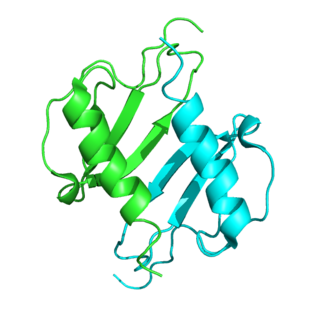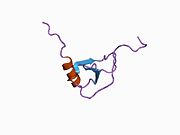
Chemokines, or chemotactic cytokines, are a family of small cytokines or signaling proteins secreted by cells that induce directional movement of leukocytes, as well as other cell types, including endothelial and epithelial cells. In addition to playing a major role in the activation of host immune responses, chemokines are important for biological processes, including morphogenesis and wound healing, as well as in the pathogenesis of diseases like cancers.

Interleukin 8 is a chemokine produced by macrophages and other cell types such as epithelial cells, airway smooth muscle cells and endothelial cells. Endothelial cells store IL-8 in their storage vesicles, the Weibel-Palade bodies. In humans, the interleukin-8 protein is encoded by the CXCL8 gene. IL-8 is initially produced as a precursor peptide of 99 amino acids which then undergoes cleavage to create several active IL-8 isoforms. In culture, a 72 amino acid peptide is the major form secreted by macrophages.

The chemokine ligand 2 (CCL2) is also referred to as monocyte chemoattractant protein 1 (MCP1) and small inducible cytokine A2. CCL2 is a small cytokine that belongs to the CC chemokine family. CCL2 tightly regulates cellular mechanics and thereby recruits monocytes, memory T cells, and dendritic cells to the sites of inflammation produced by either tissue injury or infection.
Chemokine ligands 4 previously known as macrophage inflammatory protein (MIP-1β), is a protein which in humans is encoded by the CCL4 gene. CCL4 belongs to a cluster of genes located on 17q11-q21 of the chromosomal region. Identification and localization of the gene on the chromosome 17 was in 1990 although the discovery of MIP-1 was initiated in 1988 with the purification of a protein doublet corresponding to inflammatory activity from supernatant of endotoxin-stimulated murine macrophages. At that time, it was also named as "macrophage inflammatory protein-1" (MIP-1) due to its inflammatory properties.
Chemokine ligand 1 (CCL1) is also known as small inducible cytokine A1 and I-309 in humans. CCL1 is a small glycoprotein that belongs to the CC chemokine family.

Chemokine ligand 8 (CCL8), also known as monocyte chemoattractant protein 2 (MCP2), is a protein that in humans is encoded by the CCL8 gene.

The eotaxins are a CC chemokine subfamily of eosinophil chemotactic proteins. Eotaxin is a special CC chemokine because it primarily attracts eosinophils. By being a chemoattractant for eosinophils, eotaxin has a direct relationship with inflammation. This is because eosinophils are known to promote inflammation. In order to induce stimulation, eotaxin binds with the CCR-3 receptor. The binding of eotaxin with the CCR-3 Receptor recruits eosinophils, which ultimately induces inflammation. According to early studies, the production of eotaxin can be linked to Th2 lymphocytes. Eotaxin appears to be T-cell dependent because of evidence that suggests that eosinophil recruitment is regulated by Th2 lymphocytes. The regulation occurs because of the presence of the CCR-3 Receptor on the Th2 lymphocyte. Some examples of the types of cells that have the ability of synthesizing eotaxin are lung cells, vascular endothelial cells, and macrophages.

Chemokine ligand 20 (CCL20) or liver activation regulated chemokine (LARC) or Macrophage Inflammatory Protein-3 (MIP3A) is a small cytokine belonging to the CC chemokine family. It is strongly chemotactic for lymphocytes and weakly attracts neutrophils. CCL20 is implicated in the formation and function of mucosal lymphoid tissues via chemoattraction of lymphocytes and dendritic cells towards the epithelial cells surrounding these tissues. CCL20 elicits its effects on its target cells by binding and activating the chemokine receptor CCR6.

C-C motif chemokine 22 is a protein that in humans is encoded by the CCL22 gene.

Chemokine ligand 9 (CXCL9) is a small cytokine belonging to the CXC chemokine family that is also known as monokine induced by gamma interferon (MIG). The CXCL9 is one of the chemokine which plays role to induce chemotaxis, promote differentiation and multiplication of leukocytes, and cause tissue extravasation.

C-X-C motif chemokine 11 (CXCL11) is a protein that in humans is encoded by the CXCL11 gene.

Chemokine ligand 2 (CXCL2) is a small cytokine belonging to the CXC chemokine family that is also called macrophage inflammatory protein 2-alpha (MIP2-alpha), Growth-regulated protein beta (Gro-beta) and Gro oncogene-2 (Gro-2). CXCL2 is 90% identical in amino acid sequence as a related chemokine, CXCL1. This chemokine is secreted by monocytes and macrophages and is chemotactic for polymorphonuclear leukocytes and hematopoietic stem cells. The gene for CXCL2 is located on human chromosome 4 in a cluster of other CXC chemokines. CXCL2 mobilizes cells by interacting with a cell surface chemokine receptor called CXCR2.

C-X-C motif chemokine 5 is a protein that in humans is encoded by the CXCL5 gene.
CC chemokine receptors are integral membrane proteins that specifically bind and respond to cytokines of the CC chemokine family. They represent one subfamily of chemokine receptors, a large family of G protein-linked receptors that are known as seven transmembrane (7-TM) proteins since they span the cell membrane seven times. To date, ten true members of the CC chemokine receptor subfamily have been described. These are named CCR1 to CCR10 according to the IUIS/WHO Subcommittee on Chemokine Nomenclature.

Chemokine ligand 6 (CXCL6) is a small cytokine belonging to the CXC chemokine family that is also known as granulocyte chemotactic protein 2 (GCP-2). As its former name suggests, CXCL6 is a chemoattractant for neutrophilic granulocytes. It elicits its chemotactic effects by interacting with the chemokine receptors CXCR1 and CXCR2. The gene for CXCL6 is located on human chromosome 4 in a cluster with other CXC chemokine genes.

Chemokine ligand 12 (CCL12) is a small cytokine belonging to the CC chemokine family that has been described in mice. It is also known as monocyte chemotactic protein 5 (MCP-5) and, due to its similarity with the human chemokine MCP-1, sometimes it is called MCP-1-related chemokine. CCL12 specifically attracts eosinophils, monocytes and lymphocytes. This chemokine is found predominantly in lymph nodes and thymus under normal conditions, and its expression can be hugely induced in macrophages. It is thought to coordinate cell movements during early allergic reactions, and immune response to pathogens. The gene for CCL12 is found in a cluster of CC chemokines on mouse chromosome 11.

C-C chemokine receptor type 2 (CCR2 or CD192 is a protein that in humans is encoded by the CCR2 gene. CCR2 is a CC chemokine receptor.

C-C chemokine receptor type 1 is a protein that in humans is encoded by the CCR1 gene.

C-C chemokine receptor type 3 is a protein that in humans is encoded by the CCR3 gene.

Chemokine ligand 3-like 1, also known as CCL3L1, is a protein which in humans is encoded by the CCL3L1 gene.


















